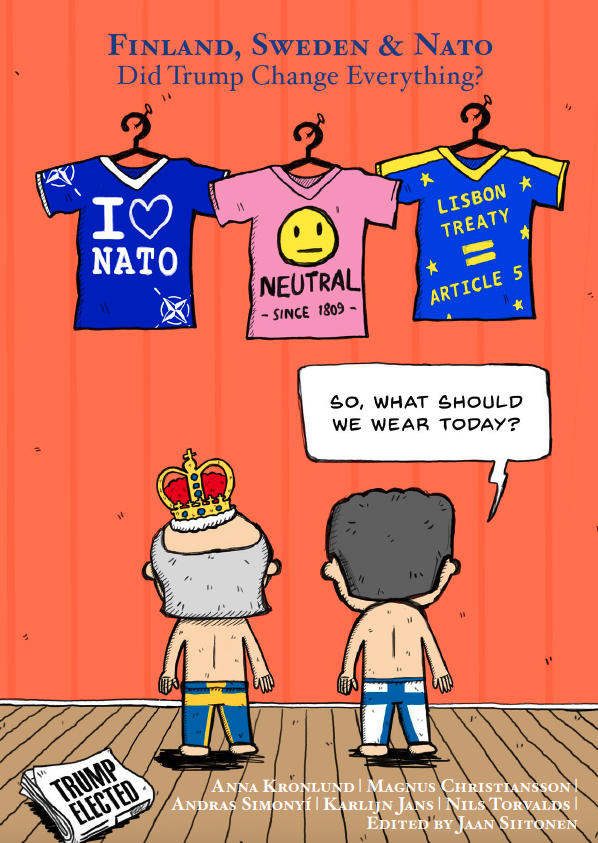
Preface
For most European countries, membership both in the EU and NATO go hand-in-hand. The total population of the European Union is some 508 million, yet only 31 million or 6% of EU citizens live in a non-NATO country.
For Europeans and Americans to better understand this minority, we wanted to produce the publication: “Finland, Sweden & NATO – Did Trump Change Everything?”. We also want to examine, whether or not Donald Trump’s first year as the President of the United States has affected the NATO debate in Finland and Sweden.
Both Finland and Sweden joined the NATO Partnership for Peace (PfP) in 1994 and have actively participated in NATO-led military exercises and crisis management operations ever since. The ideology of neutrality lives on today in both countries even though both Finland and Sweden today officially consider themselves non-aligned. However, it is also important to understand that the cases of Finland and Sweden are quite different. During the Cold War, both Finland and Sweden were neutral countries but geographical reality and the experiences in the Second World War resulted in different practices of this neutrality.
Since the end of the Cold War, there has periodically been a lively debate on whether Finland and Sweden should join the defence alliance or not. Currently the NATO debate is active in Finland due to the presidential elections in January 2018. However, the debate easily gets side-tracked and many politicians do not necessary want to proclaim their stance on NATO publicly. It is easier for them to take refuge in, for example, the referendum-argument: “Let the people decide”.
In Finland during the Cold War, NATO was a taboo subject. The case of Finland is analysed in the first Chapter by Anna Kronlund. She is an expert in U.S. institutions, and in her chapter she also analyses the so-called “Trump Doctrine”.
During the Cold War, Swedish politicians talked publicly about neutrality, although a small inner-circle of Swedish politicians had made deals with the United States in case of military crisis. Sweden’s double policy is discussed in the second chapter by Magnus Christiansson.
What about the deepening defence cooperation in the European Union? Is European Union defence cooperation enough to ensure the security of Finland and Sweden? The future of European defence cooperation is discussed in the third chapter by researcher Karlijn Jans.
What do Americans think about Finnish and Swedish non-alignment? In the fourth chapter Managing Director for the Center for Transatlantic Relations Andras Simonyi writes about the American perspective. Usually the debate revolves around how Finland and Sweden would benefit from NATO membership. Simonyi, however, analyses how NATO would benefit should the respective countries join the Alliance.
Are the European leaders doing enough developing the common security and defence policies? In the last chapter ALDE-group’s Vice-President, MEP, Nils Torvalds discusses why it is important to talk about Finland and Sweden in the corridors of Brussels and why the debate regarding NATO in these countries should interest the policymakers in Europe.
There are many people to thank who have made this publication possible. I would like to thank the authors who shared their expertise. My gratitude also goes out to the staff at the European Liberal Forum and my colleagues at the Svenska Bildningsförbundet, especially Andreas Elfving. Thanks are also due to Teemu Kiviniemi for the wonderful picture on the cover and to our proofreader Tim Glogan. I want to thank the staff at the Centre Party International Foundation, Ville Pitkänen from the think tank E2 for his thoughts and Mariette Hägglund for her great insights and comments.
The authors are presented in more detail on the next pages. Each author is solely responsible for his or her contribution.
Helsinki, November 20th 2017
Jaan Siitonen
Editor
Svenska Bildningsförbundet in Finland
The European Parliament is not responsible for the content of the publication. The views expressed in this publication are those of the authors alone. They do not necessarily reflect the views of the Svenska Bildningsförbundet, Centerpartiet’s International Foundation or European Liberal Forum.
